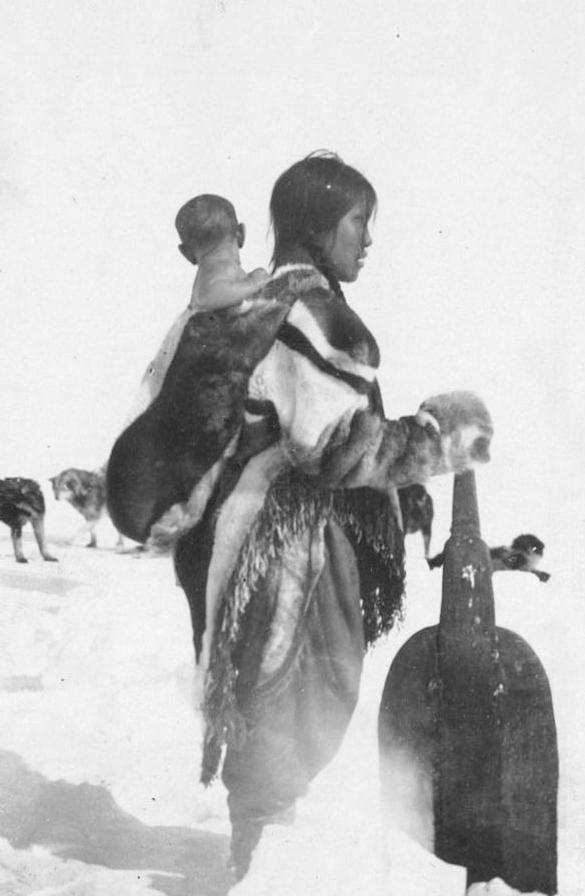
North American Native American Cultural Areas: The Arctic Cultural Area

Figure 1.--Here an Eskimo woman (probably a Central Inuit woman holds a snow shovel with a child on her back. The photograph was taken in the Boothia Peninsula, Canada, during the early 20th century. Thre Boothia Peninsula is a large peninsula in Nunavut, the northern Canadian Arctic. It is located south of Somerset Island. The northern part of the Peninsulsa, Murchison Promontory, is the northernmost point of North America. Source: Library of Congress LC-USZ62-33098).
|
|
This area occupied by the Arctic tribes includes the extreme north of North America, encompasing both the United States (Alaska) and Canada as well as Greenland. The Arctic area is a relatively narrow strip along the entire coast from the Alaskan Peninsula to the Gulf of St. Lawrence, the Aleutian Islands, and all the inhabited Arctic Islands between Banks Land and Greenland inclusive. The Arcgtic tribes face the most histile environment of all the different Native American peoples. Much of the vast area is a treeless plain, called the Arctic tundra. It is essentially treeless and covered by smow for much of the year.
The winters are long and very severe, with only a few hours of daylight. The Arctic coastline is broken and craggy and fsaces three oceans: the Pacific, the Arctic, and the Atlantic. Despite this, it is essentially a frozen desert. The people of the Arctic are united by not only climate, but also a single language family-- Inuit-Aleut. Several other terms are used to describe their language. It is part of American Arctic-Paleo-Siberian language stock, meaning that there elated dialects spoken in Siberia. This is of course futher evidence of the origins on Native Americans. It is occupied by tribes of the Eskimoan Stock, such as the Aleuts and Inuits. There are four basic cultural groupings. First, The Aleuts people the western islands. Second, the Alaskan Inuit peoples dominated the western mainlsnd, essentially Alaska. The Mackenzie Inuit of the Yukon and Yuit of Siberia share many cultural attributes. Third the Central Inuit inhabit much of the central Arctic area of Canada. They include the Netsilik Inuit, Iglulik Inuit, Copper Inuit, Caribou Inuit, Southampton Inuit, Baffinland Inuit, and Labrador Inuit. Fourt, are the eastern or Greenland Inuit. This group includes the Polar Inuit, West Greenland Inuit, and East Greenland Inuit.
HBC

Navigate the Boys' Historical Clothing Web Site:
[Introduction]
[Activities]
[Biographies]
[Chronology]
[Clothing styles]
[Countries]
[Bibliographies]
[Contributions]
[FAQs]
[Glossaries]
[Images]
[Links]
[Registration]
[Tools]
[Boys' Clothing Home]
Navigate the Boys' Historical Clothing ethnic pages:
[Return to the Main ethnic page]
[German]
[Greek]
[Irish]
[Scottish]
Navigate the Boys' Historical Clothing Native American pages:
[Return to the Main Native American cultural area page]
[Return to the Main Native American ethnic page]
[Return to the Main Native American page]
[Ethnic]
[Dance]
Created: 11:08 PM 7/19/2008
Last updated: 3:58 AM 11/15/2013



